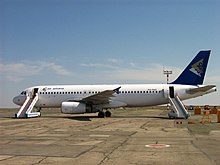Transport in Kazakhstan
The population density is low in Kazakhstan, and the centers of industry and agriculture are spread out and remote from world markets.[1] All railway lines in Kazakhstan are built in 1,520 mm (4 ft 11+27⁄32 in) gauge, of which 4,000 km (2,500 mi) is electrified (2012).KTZ cooperates with French loco manufacturer Alstom in developing Kazakhstan's railway infrastructure.[4][citation needed] Kazakhstan's developed railway system promotes international and regional trade connecting Asia and Europe.[8] There is a small (8.56 km (5.32 mi)) metro system in Almaty, the former capital and the largest city in the country.The thickness of the asphalt and concrete pavement will be 80 cm (31 in), and the expected lifespan of the highway will be 25 years, without a major overhaul, and the maximum speed limit 120 km/h (75 mph).The project includes a number of bridges over rivers, road maintenance facilities, bus stop areas, avtopavilony, cattle trails, and electronic signage.[21][22][23] The motorway network in Kazakhstan is rather underdeveloped, mainly due to the low population density in the country, which doesn't require wider roads on long distances.They include the airports of Astana, Almaty, Shymkent, Aktau, Karaganda, Ust-Kamenogorsk, Pavlodar, Kokshetau, Taraz, Petropavlovsk, and Semey.[27] Kazakhstan is actively involved in the New Silk Road initiative, which is an infrastructure project expected to significantly accelerate and reduce the cost of goods delivery from China to Europe through Central Asia.





Transport in the Soviet UnionKazakhstanKazakhstan Temir Zholy1,520 mmAlstomSovietAktobebreak of gauge1,435 mmDruzhbaAlashankouTurkestan–Siberia RailwayNorthern Xinjiang RailwayAltynkol railway stationKhorgasJinghe–Yining–Khorgos RailwayÜrümqiTurkmenistanCaspian SeaEuropeZhetigenKhorgosShaquanziRailway stations in KazakhstanAlmaty MetroTrams in AlmatyAlmatyAlatauZhibek ZholyKalkamanAstana Light MetroAstana OskemenPavlodarTemirtauRoads in KazakhstanEuropean route E40Euroroute networkAstanaChelyabinskPetropavlShymkentTashkentSamaraShchuchinskKokshetauUzynagashUzbekistanKapshagaySyr DaryaIrtyshAtyrau97 airportsopen sky regimeKaragandaUst-KamenogorskPetropavlovskAirportsNursultan NazarbayevSary-ArkaKostanayKorkyt AtaAk ZholHazret SultanBalkhashTaldykorganUsharalZaysanZhezkazganArkalykAtbasarBoraldaiEkibastuzUrzharKrayniyYubileyniyKambalaList of airports in KazakhstanPost-Soviet statesChaganDolon SouthwestAirbus-320Aktau AirportEuropean CommissionEuropean Aviation Safety AgencyAir AstanaAlmaty International AirportAstana International AirportAtyrau Airportsovereign wealth fundFarnborough AirshowFlyArystanSCAT AirlinesSunday AirlinesQazaq AirCaspiyNew Silk Roadarchive.todayTransport in Europe AlbaniaAndorraArmeniaAustriaAzerbaijanBelarusBelgiumBosnia and HerzegovinaBulgariaCroatiaCyprusCzech RepublicDenmarkEstoniaFinlandFranceGeorgiaGermanyGreeceHungaryIcelandIrelandLatviaLiechtensteinLithuaniaLuxembourgMoldova